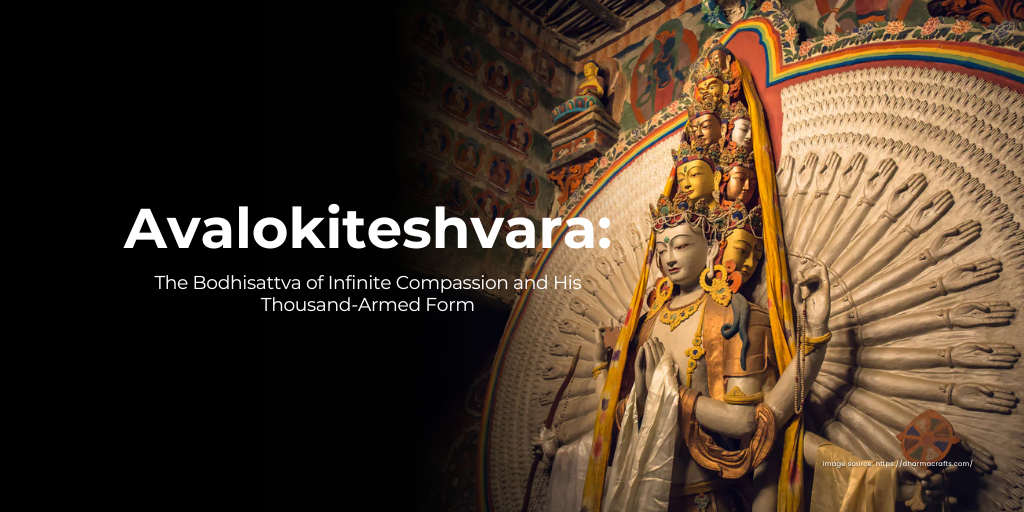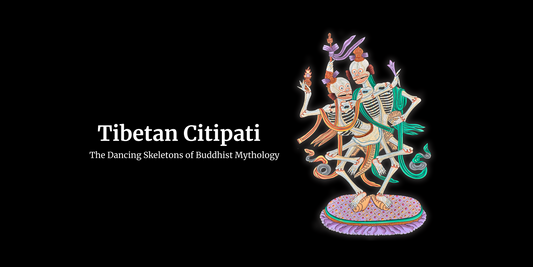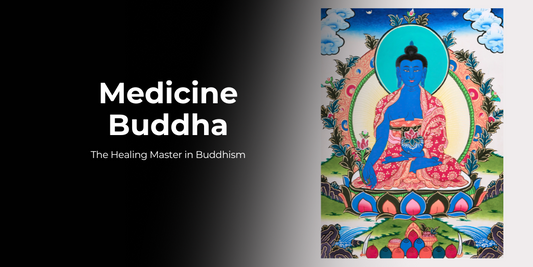- Buddhas Art of Healing
- Thangka
- Avalokiteshvara: The Bodhisattva of Infinite Compassion and His Thousand-Armed Form

Avalokiteshvara: The Bodhisattva of Infinite Compassion and His Thousand-Armed Form
People admire the Avalokiteshvara statue or thangka paintings just for their beauty. And it makes sense; complex details, cool expressions, and beautiful postures make it attractive.
But do you know that Avalokiteshvara is much more than just a beautiful art? In fact, he represents something deep and more powerful. He is the Bodhisattva of compassion.
If you are eager about Avalokiteshvara and are ready to look beyond the surface, let's start!
Who is Avalokiteshvara?
Avalokiteshvara, also known as the Bodhisattva of compassion. He is considered one of the most revered figures in Buddhism. He has reached a high level of spiritual knowledge.
His name in Sanskrit means "the Lord who sees below with compassion". Help the beings tirelessly to overcome fear and guide them to enlightenment. And this kind of commitment is central for Mahayana Buddhist philosophy.
Avalokiteshvara is represented by infinite kindness and love and is highly respected in many Buddhist cultures and traditions
He is enlightened in Buddhism and represents universal compassion. And is deeply committed to guiding others towards spiritual awakening.

Click here to explore the collection of 1000 Armed Avalokiteshvara.
The Role of Avalokiteshvara in Buddhism
Avalokiteshvara Bodhisattva: A Compassionate Vow
In Mahayana Buddhism, Avalokiteshvara embodies the ideal of selfless compassion. Rather than entering nirvana after achieving enlightenment, he vowed to remain in the world, helping sentient beings until every single one attains liberation from suffering.
This profound commitment makes Avalokiteshvara the protector of the suffering, the lost, and the desperate.
In Vajrayana and Tibetan Buddhism
In Tibetan traditions, Avalokiteshvara (Chenrezig) is central to both personal and monastic practice. The Dalai Lama is believed to be a human incarnation of Avalokiteshvara, emphasizing his importance in Tibetan culture and spirituality.
Practitioners frequently chant his mantra, "Om Mani Padme Hum", to awaken the compassionate mind and cleanse negative karma.
The Avalokiteshvara Mantra: Om Mani Padme Hum
The mantra, Om Mani Padme Hum, is perhaps the most famous Buddhist mantra in the world. Each syllable holds deep spiritual meaning:
- Om: Purifies pride
- Ma: Purifies jealousy
- Ni: Purifies passion
- Pad: Purifies ignorance
- Me: Purifies greed
- Hum: Purifies hatred
Iconography of Four-Armed Avalokiteshvara
The Four-Armed Avalokiteshvara is one of the most well-known forms of his compassionate being. He is known as Chenrezig in Tibetan Buddhism.
This form represents the essence of compassion combined with mindfulness and spiritual activity.
Each arm carries or makes a gesture that symbolizes a particular aspect of Avalokiteshvara’s compassionate activity.
|
Arm/Hand |
Object/Gesture |
Symbolic meaning |
|
First pair of hands (center, at the heart) |
Anjali mudra (prayer gesture), holding a wish-fulfilling jewel (chintamani) |
Represents compassionate intention, unity of wisdom and compassion, and the Bodhisattva’s vow to save all beings. The jewel symbolizes the Bodhichitta mind—the aspiration to attain enlightenment for the benefit of others |
|
Third Hand (right side) |
Mala (rosary beads) |
Represents continuous prayer, mindfulness, and the practice of reciting “Om Mani Padme Hum”. The mala also symbolizes the cyclic nature of life and the path of liberation |
|
Fourth Hand (left side) |
Lotus flower (padma) |
Symbolizes purity and spiritual awakening. Just as the lotus grows unstained from mud, a compassionate heart remains pure even in a world of suffering. |
|
Calm Face |
Serene smile with soft gaze |
Compassionate presence and inner peace |
|
Lotus seat (Padmasana) |
Sitting posture on a lotus flower |
Symbolizes purity and enlightenment |

Four-armed Avalokiteshvara is a living representation of compassion, wisdom, and spiritual practice. His form teaches us how to be kind in our words, deeds, and thoughts.
The Thousand-Armed Avalokiteshvara: Compassion Without Limits
Who is the Thousand-Armed Avalokiteshvara?
The thousand-armed Avalokitehvara is one of the most iconic and spiritually significant forms of Avalokiteshvara. In Sanskrit, he is known as Sahasrabhuja Avalokiteshvara.
Thousand-armed Avalokiteshvara is considered the most profound and magnificent expression of his compassionate power. His manifestation represents compassion, unbound wisdom, and the infinite ability to assist all sentient beings.
His numerous arms and eyes stand for his ability to assist countless beings at once. He guides, protects, and heals every being with compassion that knows no boundaries.
In Buddhist belief, he is the compassionate protector who perceives the suffering of every being and addresses them with skillful action.
Origin Story of Thousand-Armed Avalokiteshvara
The story of Thousand-Armed Avalokiteshvara comes from a powerful and symbolic legend. This legend is shared in many Buddhist traditions, especially in Mahayana and Vajrayana Buddhism.
According to Buddhist texts, Avalokiteshvara made a profound vow at the beginning of his spiritual journey. He promised:
“I will not rest if there is even one being left in pain. If I ever betray this promise, may my body fall apart.”
He spent innumerable years trying to reduce the pain of all living beings. But was deeply saddened when he realized that sufferings are unending. Overwhelmed by compassion, his body broke into pieces, showing how deeply he cared for the world’s suffering.

Explore this sacred image of the 1000-armed Avalokiteshvara Bodhisattva, radiating compassion through a thousand helping hands.
When Avalokiteshvara’s body broke from sorrow, his teacher, Amitabha Buddha, stepped in.
Out of compassion, Amitabha rebuilt him in a stronger form:
- Eleven heads, to hear the cries of all beings
- 1,000 arms, to help everywhere at once
- Eyes in each palm, to see clearly and act wisely
This form shows a powerful message: “When compassion feels overwhelmed, it’s not a sign to give up but a chance to grow and serve even more deeply.”
Symbolism of the Thousand-Armed Avalokiteshvara
1. Eleven Heads
Eleven heads represent different states of compassion, wisdom, and awareness. These heads represent his ability to see and understand the sufferings of beings across different realms.
2. 1,000 Arms
Represent the infinite ways Avalokiteshvara reaches out to help beings.
3. Eyes in Each Palm
Symbolize all-seeing wisdom and compassionate action. 1000-Armed Avalokiteshvara sees suffering clearly and responds immediately.
Let the lotus and mala remind you of purity and to stay mindful, respectively. Explore our sacred 1000-armed Avalokiteshvara Thangkas.
Why is thousand-armed Avalokiteshvara so loved?
1000-Armed Avalokiteshvara is a living symbol of kind action, all-visible knowledge, and spiritual dedication. His story inspires us to develop courage to face suffering without any distance.
1. Universal symbol of compassion
1000-Armed Avlokiteshwara is given love and respect because he represents the ultimate ideal of compassion. His 1000 arms and eyes symbolize help without any limit.
When we feel our compassion is not enough, we should not give up. Instead, we should develop it even more and help others.
2. Protection and Healing
Many Buddhists believe chanting the Great Compassion Dharani or focusing on a thousand-armed Avalokiteshvara statue or thangka brings:
- Spiritual protection from obstacles
- Emotional and physical healing
- Relief from sorrow, fears, and misfortunes
-
Longevity and inner blessings
3. Role in Buddhist practice
He is important in Mahayana and Vajrayana Buddhist rituals. Monks, nuns, and lay practitioners visualize him during meditation, chant his mantras, and carry out rituals invoking his blessings.
4. An inspiration for practitioners
Avalokiteshvara's story reflects that compassion has to be unbounded, even when it appears beyond us. In a world of suffering, his form embodies that no matter how bad things appear, we can always and should always search for ways to be of assistance to others.
At Buddha's Art of Healing, we preserve and honor this sacred tradition by offering hand-painted objects made by Himalayan artists. We bring ancient knowledge of compassion, treatment, and art for his life.

1. Are Guanyin and Avalokiteshvara the same?
Yes, in Chinese Buddhism, Avalokiteshvara manifests as Guanyin, often in a female form. Both represent the same essence of universal compassion.
2. What distinguishes the 1000-armed Avalokiteshvara from the four-armed Avalokiteshvara?
The four-armed form symbolizes compassion in daily life, while the thousand-armed form represents limitless action and wisdom to help all beings at once.
3. Do I need a teacher to start Avalokiteshvara practice?
Teachers can be helpful for advanced practice. But for meditation, anyone anywhere can begin the Avalokiteshvara practice.
Practicing Avalokiteshvara opens our hearts to the needs of this world. 1000-Armed Avalokiteshvara reinforces compassion. His skillful action heals the beings and uplifts them.
At Buddha’s Art of Healing, we are pleased to provide authentic Avalokiteshvara thangkas made by Himalayan artisans.
Also, if you have time, do check out our Instagram and Facebook, where we post more interesting details on thangkas.



